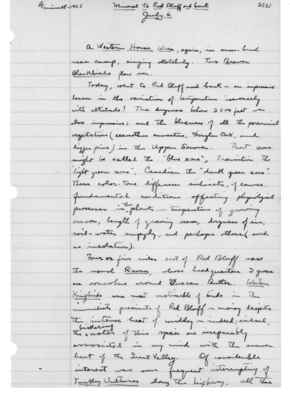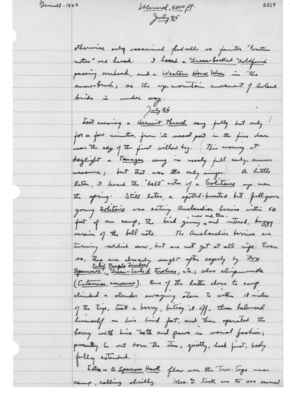Pages That Mention snow bush
1925: Joseph Grinnell's field notes
S2 Page 68
Collector: Grinnell - 1925 Location: Mineral to Red Bluff and back Date: July 6 Page Number: 2521
A western House Wren, again, in snow-brush near camp, singing sketchily. Two Brewer Blackbirds flew over.
Today, went to Red Bluff and back - an impressive lesson in the variation of temperature inversely with altitude! The dryness below 3500 feet was also impressive; and the blueness of all the perennial vegetation (ceanothus cuneatus, Douglas Oak, and digger pine) in the Upper Sonoran. That zone might be called the "blue zone", Transition the "light green zone", Canadian the "dark green zone". These color-tone differences indicate, of course, fundamental conditions affecting physiological processes in ^the plants - temperature of growing season, length of growing season, dryness of air, soil-water supply, and perhaps others (such as insolation).
Four or five miles east of Red Bluff saw the usual Raven, whose headquarters I guess are somewhere around Tuscan Buttes. Western Kingbirds were most noticeable of birds in the immediate precincts of Red Bluff - noisy despite the intense heat of midday - indeed; indeed, the ^bickering notes of this species are inseparable, associated in my mind with the summer heat of the Great Valley. Of considerable interest was our frequent interrupting of Turkey Vultures along the highway, all the
S2 Page 76
Collector: Grinnell - 1925 Location: Mineral, 4800 ft. Date: July 25 Page Number: 2529
otherwise only occasional food calls or fainter "location notes" are heard. I heard a Green-backed Goldfinch passing overheard, and a Western House Wren in the snow-brush; so the up-mountain movement of lowland birds is under way.
July 26 Last evening a Hermit thrush sang fully but only for a few minutes, from its usual post in the firs down near the edge of the first willow bog. This morning at daylight a Tanager sang in nearly full early summer measure; but that was the only singer. A little later, I heard the "bell" notes of a Solitaire up near the spring. Still later, a spotted-breasted but full-grown young Solitaire was eating Amelanchier berries within 50 feet of our camp, the bird giving ^now and then an intoned, buzzy version of the bell note. The Amelanchier berries are turning reddish now, but not yet at all ripe. Even so, they are already sought after eagerly by Fox Sparrows, ^Calif. Purple Finches, Green-tailed Towhees, etc; also chipmunks (Eutamias amoenus). One of the latter close to camp climbed a slender swaying stem to within 18 inches of the tip, took a berry, biting it off, then balanced himself on his hind feet, and then operated the berry with his teeth and paws in usual fashion; presently he went the stem, quietly, head first, body fully extended.
Later - A Sparrow Hawk flew over the tree-tops near camp, calling shrilly. Mrs. G. took me to see several

